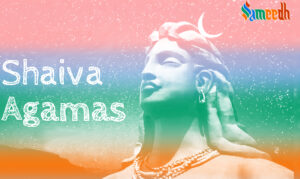Shaiva Siddhant is a prominent school of philosophy within the broader framework of Shaivism, one of the major traditions in Hinduism. It emphasizes the path of devotion (bhakti) and knowledge (jnana), as well as the importance of rituals and ethical conduct. The philosophical system of Shaiva Siddhant is based on a set of scriptures known as Agamas.

The Shaiva Siddhant Agamas are part of the broader framework of Shaiva Agamas, The Twenty-eight Saiva Agamas, also known as the Siddhant Agamas, are a group of scriptures that form the basis of the Shaiva Siddhant tradition. These Agamas provide guidelines for the worship of Lord Shiv, temple construction, rituals, and philosophical principles. The Saiva Agamas are considered authoritative texts in the Shaiva Siddhant tradition.
There are 28 Saiva Agamas, and these are categorized into four groups:
- Charya Agamas (conduct): The Charya Agamas emphasize the external aspects of worship, outlining the prescribed rituals, observances, and ethical conduct for the followers. These rituals are often performed in temples and form an integral part of the devotional practices in Shaiva Siddhanta. These focus on the conduct of the devotees and the rituals associated with public worship. Some of the Charya Agamas include:
- Aagama Prakarana : deal with the overall principles of the Agamas.
- Candrajnana Prakarana : involve lunar worship and rituals.
- Kriyapada Prakarana : elaborate on specific actions and ceremonies.
- Carya Pada Prakarana : cover the general conduct and behavior expected of devotees.
- Kriya Agamas (rituals): The Kriya Agamas are a category of scriptures within the Shaiva Agamas that primarily focus on rituals and the practical aspects of temple worship. “Kriya” translates to “action” or “ritual,” and these texts provide detailed instructions on how to perform various ceremonies, including the consecration of temples and the worship of deities. The Kriya Agamas guide the external and internal aspects of ritualistic worship in Shaivism. These deal with the rituals and procedures for temple worship, including the consecration of deities.
- Vatula Agama
- Vira Agama
- Rudra Yamala
- Maha Candrajnana
- Mukhabimba Agama
- Svayambhuva Agama
- Paramesvara Samhita
- Vijaya Sangraha
- Raurava Agama
- Yoga Agamas (discipline): The Yoga Agamas are a category of scriptures within the Shaiva Agamas that focus on the practice of yoga and the spiritual disciplines associated with it. These texts provide guidance on various aspects of yoga, including both physical and mental practices, aimed at achieving spiritual realization and union with the divine.These Agamas provide insights into various forms of yoga, including Hatha Yoga, Raja Yoga, and Kundalini Yoga, among others. They cover practices such as asanas (physical postures), pranayam (breath control), meditation, and techniques for spiritual awakening. The Yoga Agamas emphasize the importance of integrating physical, mental, and spiritual practices to attain higher states of consciousness and ultimately achieve union with the divine. These provide insights into the yogic practices and spiritual disciplines for attaining union with the divine.
- Mrigendra Agama
- Matsya Agama
- Kurma Agama
- Dhanada Agama
- Makuta Agama
- Sveta Agama
- Karana Agama
- Amsumad Bheda Agama
- Jnana Agamas (knowledge): The Jnana Agamas are a category of scriptures within the Shaiva Agamas that focus on philosophical teachings and the pursuit of knowledge. The term “Jnana” translates to “knowledge” in Sanskrit, and these texts delve into the metaphysical and philosophical aspects of Shaivism. The Jnana Agamas are concerned with understanding the nature of reality, the self (Atman), and the ultimate reality (Brahman).These Agamas discuss topics such as the nature of the divine, the relationship between the individual soul (jiva) and the supreme reality (Shiv), the path of knowledge (Jnana Yoga), and the means of attaining spiritual enlightenment. The Jnana Agamas are particularly important for those who seek to understand the philosophical underpinnings of Shaiva Siddhant. They provide a theoretical framework for the practical aspects of worship and ritual found in other categories of Agamas. By exploring the teachings of the Jnana Agamas, practitioners can deepen their understanding of the ultimate reality and the path to liberation. These emphasize the philosophical aspects and knowledge of the ultimate reality.
- Karana Agama
- Ajita Agama
- Dipta Agama
- Sukshma Agama
- Sahasra Kirana Agama
- Amshumad Agama
The Agamas form the basis for the rituals performed in Shaiva Siddhanta temples and guide the followers in their spiritual practices. It is important to note that different sects within Shaivism may follow different sets of Agamas, and the Shaiva Siddhant tradition has its unique interpretation and emphasis on these scriptures.
These Agamas cover a wide range of topics, including rituals, philosophy, temple architecture, and spiritual practices. The Shaiva Siddhant tradition places great importance on adhering to the teachings and practices outlined in these scriptures for the proper worship of Lord Shiv and spiritual growth. Different sects within Shaivism may prioritize specific Agamas, and interpretations may vary, but collectively, they form a foundational framework for the Shaiva Siddhant tradition.
